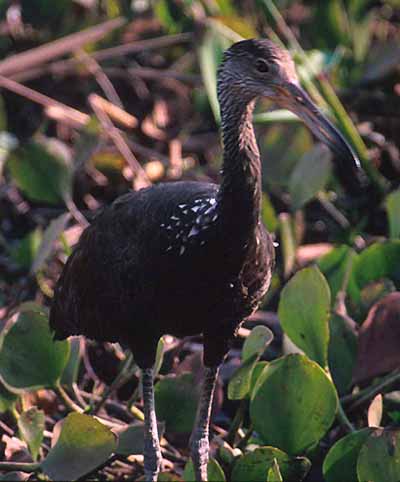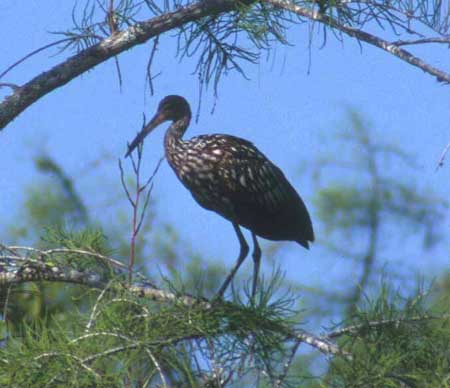LIMPKIN Aramidae
-
Species in family 1
-
Species observed [DR] 1 (100%)
-
Species photo'd [DR] 1
 The
Limpkin
(left and below) is a strange marsh bird of the New World tropics. It looks
superficially like an ibis, has the general anatomy of a crane, and shares
many behavioral traits with rails. Recent DNA evidence places it close
to the sungrebes & finfoots (Sibley & Ahlquist 1990). Bryan (1996)
calls it "one of the many remarkable birds of the Americas, with its unique
appearance, unusual diet and extraordinary calls [and] an unusual variety
of nesting sites, ritualistic courtship feeding, and a mix of monogamy
and polyandry...". Between 1856-1934, the Limpkin was considered to be
composed of two species, but now everyone agrees it is a single variable
species. The two main types are shown in these two photos: South American
birds (above & left) have unmarked dark brown backs and wings,
while northern birds such as those in Florida (illustrated below
or right in another nice Greg Lasley photo) have backs & wings
heavily spotted with white.
The
Limpkin
(left and below) is a strange marsh bird of the New World tropics. It looks
superficially like an ibis, has the general anatomy of a crane, and shares
many behavioral traits with rails. Recent DNA evidence places it close
to the sungrebes & finfoots (Sibley & Ahlquist 1990). Bryan (1996)
calls it "one of the many remarkable birds of the Americas, with its unique
appearance, unusual diet and extraordinary calls [and] an unusual variety
of nesting sites, ritualistic courtship feeding, and a mix of monogamy
and polyandry...". Between 1856-1934, the Limpkin was considered to be
composed of two species, but now everyone agrees it is a single variable
species. The two main types are shown in these two photos: South American
birds (above & left) have unmarked dark brown backs and wings,
while northern birds such as those in Florida (illustrated below
or right in another nice Greg Lasley photo) have backs & wings
heavily spotted with white.
Note the odd gap near the end of the decurved bill, another unusual
feature shared with only a few other birds, such as the two species of
open-billed storks (Anastomus) of the Old World. The bill is designed
to deal with right-handed apple snails (Pomacea) on which the Limpkin
depends. The bill bends to the right near the tip -- quite possibly because
of the frequent insertions into the snail -- and the upper tip is sharpened
against the lower tip to create a "knife-tip" point to cut the snail's
attaching muscles. [Another species heavily dependent on apple snails is
the Snail Kite Rostrhamus sociabilis, and the ranges of the two
birds -- from s. Florida to n. Argentina -- are remarkably similar.]
 The
English name "limpkin" comes from "a characteristic limping gait" but "this
feature is by no means apparent to all observers" (Bryan 1996). I've never
seen one "limp." I watched one in Florida just last week feeding on a small
shaded pond by standing thigh-deep in the pool quietly -- like an ibis
or stork -- while nearby Little Blue and Tricolored herons were stalking
about slowly on the thick water lilies. In truth, although the Limpkin
can appear awkward, it is a strong flier, a good swimmer, and a fast runner.
John J. Audubon said the few birds excelled it in speed and that it could
not be caught by even his best dogs.
The
English name "limpkin" comes from "a characteristic limping gait" but "this
feature is by no means apparent to all observers" (Bryan 1996). I've never
seen one "limp." I watched one in Florida just last week feeding on a small
shaded pond by standing thigh-deep in the pool quietly -- like an ibis
or stork -- while nearby Little Blue and Tricolored herons were stalking
about slowly on the thick water lilies. In truth, although the Limpkin
can appear awkward, it is a strong flier, a good swimmer, and a fast runner.
John J. Audubon said the few birds excelled it in speed and that it could
not be caught by even his best dogs.
Bryan (1996) notes that the vocalizations of several males calling at
once is "one of the weirdest cacophonies of nature." The calls are mostly
given at night and have been described as: "a hoarse rattling cry like
the gasp of person being strangled;" "little boys lost in the swamps forever;"
an unearthly shriek" with the "quality of unutterable sadness." These night
cries have led to many legends and tales, and in parts of Amazonia it is
believed that when the limpkins begin calling in earnest, the water levels
in the rivers will not rise any further.
Photos: The upper photo of a southern Limpkin
Aramus guarauna guarauna was taken in the Pantanal of Mato Grosso,
Brazil, in July 1999; Greg W. Lasley took the lower photo of a northern
Limpkin
Aramus g. pictus in southern Florida in April 1990 .
Upper
photo © 2000 Don Roberson, lower photo © 2000 Greg W. Lasley
(used with permission); all rights reserved.
Bibliographic note:
There is no "family book" per se of which I'm aware, but an excellent
introduction to the family -- including much more on its biology -- is
in Bryan (1996). Strangely enough, though, that introduction does not feature
the variety of exceptional photos we have otherwise come to expect from
the Handbook of the Birds of the World series.
Literature cited:
Bryan, D. C. 1996. Family Aramidae (Limpkin) in del Hoyo, J.,
Elliott, A., & Sargatal, J., eds. Handbook of the Birds of the World.
Vol. 3. Lynx Edicions, Barcelona.
Sibley, C. G., and J. E. Ahlquist. 1990. Phylogeny and Classification
of Birds: A Study in Molecular Evolution. Yale Univ. Press, New Haven,
CT.
TOP
BACK TO HOME
PAGE
BACK TO LIST OF
BIRD FAMILIES OF THE WORLD
Page created 23 Apr 2000
 The
English name "limpkin" comes from "a characteristic limping gait" but "this
feature is by no means apparent to all observers" (Bryan 1996). I've never
seen one "limp." I watched one in Florida just last week feeding on a small
shaded pond by standing thigh-deep in the pool quietly -- like an ibis
or stork -- while nearby Little Blue and Tricolored herons were stalking
about slowly on the thick water lilies. In truth, although the Limpkin
can appear awkward, it is a strong flier, a good swimmer, and a fast runner.
John J. Audubon said the few birds excelled it in speed and that it could
not be caught by even his best dogs.
The
English name "limpkin" comes from "a characteristic limping gait" but "this
feature is by no means apparent to all observers" (Bryan 1996). I've never
seen one "limp." I watched one in Florida just last week feeding on a small
shaded pond by standing thigh-deep in the pool quietly -- like an ibis
or stork -- while nearby Little Blue and Tricolored herons were stalking
about slowly on the thick water lilies. In truth, although the Limpkin
can appear awkward, it is a strong flier, a good swimmer, and a fast runner.
John J. Audubon said the few birds excelled it in speed and that it could
not be caught by even his best dogs.
 The
Limpkin
(left and below) is a strange marsh bird of the New World tropics. It looks
superficially like an ibis, has the general anatomy of a crane, and shares
many behavioral traits with rails. Recent DNA evidence places it close
to the sungrebes & finfoots (Sibley & Ahlquist 1990). Bryan (1996)
calls it "one of the many remarkable birds of the Americas, with its unique
appearance, unusual diet and extraordinary calls [and] an unusual variety
of nesting sites, ritualistic courtship feeding, and a mix of monogamy
and polyandry...". Between 1856-1934, the Limpkin was considered to be
composed of two species, but now everyone agrees it is a single variable
species. The two main types are shown in these two photos: South American
birds (above & left) have unmarked dark brown backs and wings,
while northern birds such as those in Florida (illustrated below
or right in another nice Greg Lasley photo) have backs & wings
heavily spotted with white.
The
Limpkin
(left and below) is a strange marsh bird of the New World tropics. It looks
superficially like an ibis, has the general anatomy of a crane, and shares
many behavioral traits with rails. Recent DNA evidence places it close
to the sungrebes & finfoots (Sibley & Ahlquist 1990). Bryan (1996)
calls it "one of the many remarkable birds of the Americas, with its unique
appearance, unusual diet and extraordinary calls [and] an unusual variety
of nesting sites, ritualistic courtship feeding, and a mix of monogamy
and polyandry...". Between 1856-1934, the Limpkin was considered to be
composed of two species, but now everyone agrees it is a single variable
species. The two main types are shown in these two photos: South American
birds (above & left) have unmarked dark brown backs and wings,
while northern birds such as those in Florida (illustrated below
or right in another nice Greg Lasley photo) have backs & wings
heavily spotted with white.